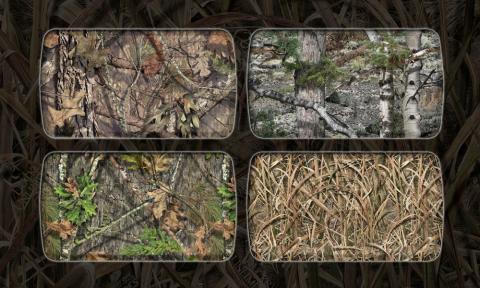Greg Veire has been a Mossy Oak ProStaffer since 2012. Greg originally lived and hunted in Minnesota, but today he lives in Las Vegas, Nevada. In Minnesota, he hunted whitetails, but when he moved to Las Vegas, he entered a new world of mule deer hunting.
Whitetails Versus Mule Deer - As Different As Night and Day to Hunt
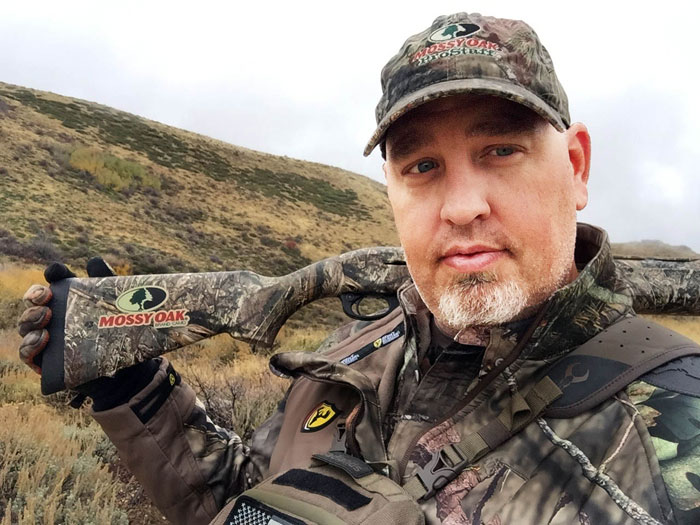
When I lived in Minnesota, I hunted with a shotgun and took between 15 and 20 bucks. Most of the time I was using the spot-and-stalk method of deer hunting, but I also took seven bucks hunting from a tree stand. My best buck in Minnesota scored 156 inches. I moved to Las Vegas to work, but I didn’t want to give up deer hunting. I quickly learned that hunting white-tailed deer in Minnesota and hunting desert mule deer in Las Vegas was as different as night and day.
In Minnesota, I hunted flat, agricultural fields like soybeans and corn. I was from the southwestern corner of Minnesota, which was almost all farm country. There weren’t very many trees, so I hunted numbers of sloughs and swamp bottoms. When I moved to Las Vegas, I found I could use the spot-and-stalk technique for mule deer that I’d used in Minnesota, but instead of easy walking, I was climbing mountains.
I also quickly learned that you couldn’t pattern mule deer here in the West like we did whitetails in Minnesota. I learned, too, that hunting mule deer was much more physically draining than hunting whitetails in Minnesota. I have to describe Minnesota hunting as a walk in the park, compared to a mountain-climbing excursion here in the West.
In Minnesota, I easily could stroll to a place where I planned to hunt, without having to get in shape for deer season. But here in Las Vegas, I have to get in the best physical shape that I can to get back into the mountains and hunt where most people won’t hunt. Luckily, I had a Mossy Oak ProStaff buddy, Robert Bertling, who lived out here in Las Vegas. He found out that I loved to hunt and that I was from Minnesota but didn’t really have a clue about where to find a mule deer buck. So, he took me up into the Ruby Mountains, which are about an 8-hour drive from Las Vegas.
Lesson One for Hunting Mule Deer - Use the Proper Equipment
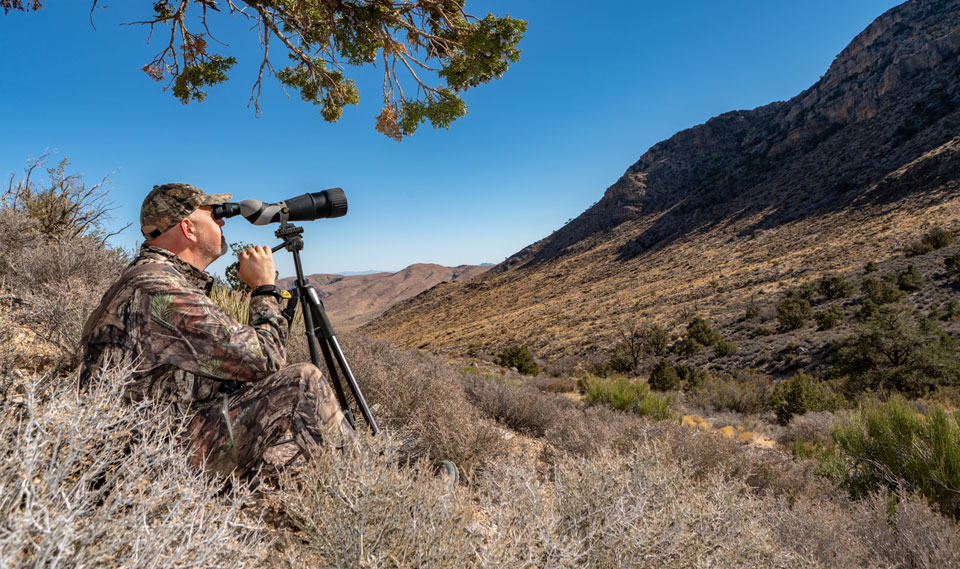
My first lesson was on how to glass using binoculars and a spotting scope. I didn’t really use binoculars very much in Minnesota, and I quickly learned that mule deer hunting was much more technical than the whitetail hunting I was doing in Minnesota.
When glassing, we’d climb to a vantage point, sit down and study every branch, twig, tree, patch of grass or any type of cover that possibly could be holding a mule deer. Instead of looking for a deer like I did in Minnesota after a snow, we were looking for ear tips, antlers sticking up, a swish of a tail, a white rump or anything that looked out of place from the vegetation.
Next, I learned we’d have to use a spotting scope, to see exactly what that odd something was. In Minnesota, I could drive by an agricultural field and say, “Oh, there’s one out in that field. I’ll get out of sight and slip in close enough to take him.” I’ve learned that when you’re hunting in the mountains, you have to drive as close as you can to a mountain, then climb the mountain, look for a vantage point where you can see the other side of the mountain and start glassing.
I had some inexpensive Wal-Mart 10x42 binoculars when I hunted in Minnesota. When I came to Las Vegas, I had to upgrade my optics to Leupold binoculars and a spotting scope. I use the Leupold Kenai spotting scope. Another piece of equipment I had to buy that I never used in Minnesota was a tripod on which to rest my binoculars and/or spotting scope.
In Minnesota, I didn’t pay much attention to the kind of footwear I used as long as the boots were warm, and my daypack wasn’t particularly critical either. But when I arrived in Nevada, I needed to buy boots that could withstand the rigors of mountain climbing, and I had to buy a frame pack that not only would carry my hunting gear, but also allow me to pack meat out. I learned that western mule deer hunting success was more about the gear you had to be able to hunt effectively than it was about the skills you needed to find and take mule deer.
In Minnesota, all I needed was to wear some Mossy Oak camouflage and have a gun and some shells. In Minnesota, I never used a pack. When I shot a deer, I could drive up to him with my pickup truck, load him up and take him home or to the processor. I now use an Eberlestock pack. I can load that pack up with one or two quarters of a deer and carry the meat out comfortably.
I use a Havalon knife to cape, skin and debone my mule deer. I have a friend who owns a taxidermy shop out here, and that’s the only knife they use. When I started using it, I understood why. That knife has a surgical blade, and you can change the blades out when one gets dull. In Minnesota, I just used a folding Buck knife. That was the knife my dad had given me back when I was growing up and hunting with him, and I’ve never seen the need to change.
In Minnesota, I might get one of those little plastic bottles of water and put it in my pocket, but out in Nevada, I started carrying one of those bladder-type water systems. I haven’t started using a walking stick yet, but I’m seriously considering getting one this year. I’ve talked to a lot of veteran hunters here, and they say that with a walking stick, they’re not putting as much pressure on their knees. I’m 6’4” and a fairly large guy, and I’m starting to see that a walking stick would be a definite advantage to use when I’m hunting mule deer.
Rifle Versus Bow for Western Hunting
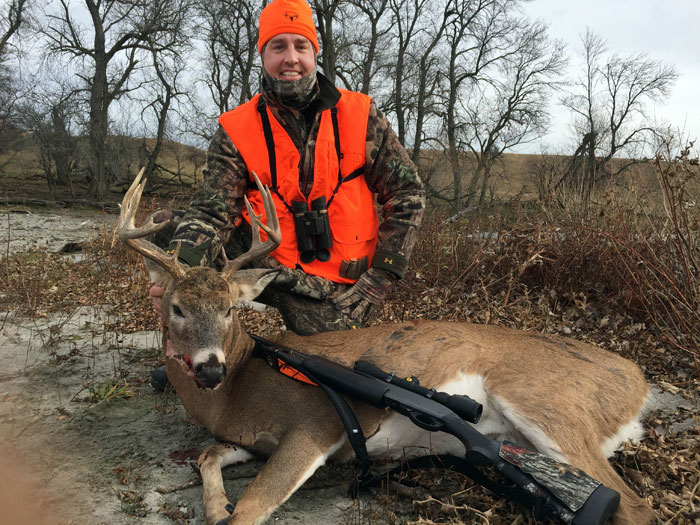
In Minnesota, I hunted with a Remington 870 shotgun, shooting 2-3/4-inch sabot slugs. I still hunt with that same gun when I go back home to deer hunt. I couldn’t really believe the difference that shooting a rifle made from shooting a shotgun. I never owned a rifle until I moved to Las Vegas. So, I not only had to learn a different way of hunting in Nevada, I also had to learn a different way of shooting.
I have a Vortex scope on that rifle, and I now can shoot accurately at 900-1000 yards. I couldn’t even think about seeing a deer at that range in Minnesota. The furthest I’ve ever shot a deer in Nevada was 426 yards. The furthest I had taken a deer in Minnesota was at 60 yards. So, learning how to take long-range shots was a really new challenge for me. I never owned a range finder, until I moved to Nevada. In Minnesota, if I could see a deer, I could shoot him with my shotgun. But with my range finder, I now range the deer I’m planning to shoot, and my range finder will give me an accurate range out to 1000 yards. At home, most of the time we’d take running shots at deer coming out of soybean or corn fields. But in Nevada, the deer will stand still and let you shoot them.
Although I’ve got a rifle that I know I can reach out and touch a mule deer with, I really prefer to hunt with a bow and arrow. After I learned to shoot the bow, most of the deer I took with my bow in Minnesota were at 20 yards or less out of a tree stand. The biggest white-tailed buck I ever shot scored 156, and I shot him with my bow. Out here in Nevada, the biggest mule deer buck I’ve ever taken was in velvet and scored about 175-180. I shot him at 45 yards. Back home, I’d never think about taking a shot that far.
Even though I’m shooting the same Mathews bow I’ve hunted with in Minnesota, in Nevada, I’ve added a Spot Hogg sight called the Seven Deadly Pins. Now I can shoot out to 100 yards, but I’m not necessarily accurate out to 100 yards. I’ve increased my range now, so I feel comfortable shooting out to 70 yards. I had to learn how to shoot long range with a bow as well as with a rifle. I couldn’t even imagine shooting accurately at 70 yards when I was bowhunting in Minnesota. I had to go out into the desert and practice shooting early in the morning before the weather got too hot, because the maximum range I could shoot in my backyard was only 20 yards.
I made friends with a fellow who owns a bow shop out here, and he set up my bow for hunting mule deer. I had always shot with a Spot Hogg sight, but I only had 5 pins on it. When my friend set up my bow, he said I needed 7 pins. He helped me learn to shoot at those longer distances. I never really had to learn how to adjust for shooting uphill or downhill in Minnesota because the ground was so flat. But my sight now adjusts for the angle of shooting up or down, and it tells me which pin to shoot.
I also changed my release, because it was causing the bow to fire before I wanted it to fire. I switched to a Tru-Fire release. My broadheads also evolved. I now shoot Black Eagle Carnivore shafts and a Swhacker broadhead. I took my new arrows out to a game ranch to shoot a hog to see how I would like them, and I shot the hog right through the shoulder, where a hog has a gristled plate. I got a full pass through both shoulders. I never would have believed that shot if I hadn’t seen it. Before that I was using a great fixed broadhead. I really loved that broadhead, and I shot an elk with that broadhead. But when I saw what the Swhacker did to that hog, I decided to change broadheads. I’ve taken several different animals with the Swhacker, and I’ve been really pleased with the way it shoots and the speed with which it puts the animal down.
Arizona, Nevada and New Mexico Mule Deer Hunting
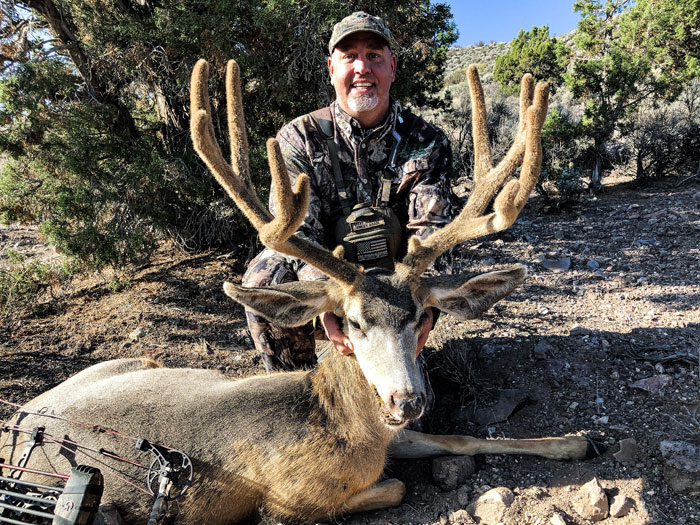
Out here in the West, you have to draw tags for just about every game animal you want to hunt. I had to wait five years to draw a mule deer tag to take a nice mule deer buck in the velvet that I took this year. To solve this problem, I hunt in Arizona as well as in New Mexico. I hunt mule deer in Arizona, but I haven’t had an opportunity to go after Coues deer. That’s on my bucket list. In Minnesota, I didn’t have to go out of state to hunt deer. But now, where I hunt mainly depends on where I can draw a tag to hunt.
Another thing that’s unusual in the West is not only do you have to draw a tag, you have to put in for tags to hunt certain units. The reason it took me five years to draw a tag for the big mule deer buck I took was because I had one particular unit I wanted to hunt - Unit 241, which I think is the best unit in Nevada to hunt for mule deer. When I didn’t draw Unit 241, I’d also put in for Unit 10, which is up in the Ruby Mountains where I first learned to hunt mule deer. That’s an area where the most tags are given out. The mule deer up there aren’t as big as in Unit 241, but you can draw a tag almost every year for Unit 10. I did take two decent 4x4 mule deer bucks in Unit 10, one scoring about 125 and the other about 135.
In Minnesota, I could take my deer to the processor, and he would cape, quarter and butcher my deer. Here in Nevada, often you’re so far from your vehicle you usually have to do your own caping, field dressing, quartering and carrying the meat out. Depending on how deep in the mountains I am, I also may have to debone the deer. If I’m only hunting a mile from my truck, I’ll just quarter the deer and carry him out bones and all, or if I have a friend hunting with me, the two of us can carry the deer out. I did have to debone a deer one time, because I took him in a very deep canyon and didn’t want to climb that mountain more than one time to get my deer out. I not only brought the meat out, but the horns and the head as well.
Important Things to Know to Be Successful Hunting Mule Deer
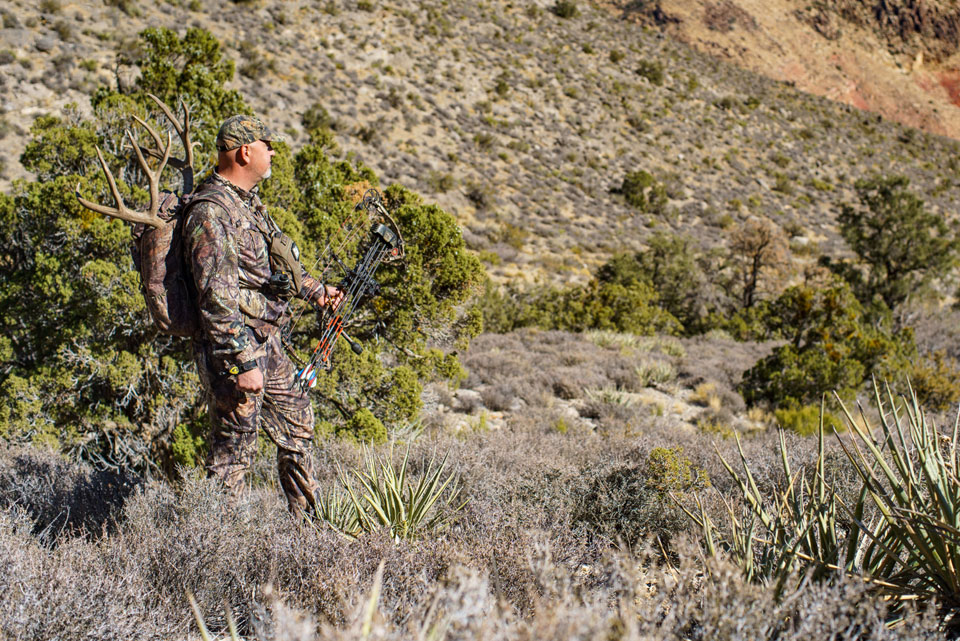
When bowhunting mule deer, I always recommend you take the first mule deer you have an opportunity to harvest. Be sure to calm yourself down before you take the shot and mentally go through your shot routine. Shoot as much as you can from 20-80 yards before you come out West. Try to shoot a group at 80 yards that’s the size of a pop can. Practice, practice, practice.
Also here in the West, the wind can have an effect on your arrow flight. I’ve never had a problem when I shoot out to 40 yards. But on a windy day, I won’t take a 70-yard shot. Also, I believe the mule deer sees with his nose, so you really have to be aware of controlling your scent. I shower every day with some type of odor-killing soap before I go hunting, and I spray down as needed with odor-killing spray. If I get to a spot where I know deer are crossing and I take a stand, I’m constantly checking the wind with a puffer-style wind checker. I make sure that I’m not in a buck’s scent cone when I try to stalk him. I also range different trees when I’m in a spot I expect the buck to come to, so I know the range I may have to shoot without having to pull up my range finder once the deer comes into view. I don’t want to make any movement other than drawing my bow when I’m within 60 yards of the mule deer.
I’ve tested new technology this year. I’ve been wearing a HECS bodysuit. At first I didn’t have a lot of faith in it, but then after wearing it this season, I’ve had many deer walk within 10 yards of me and never even look at me. I was really impressed by that HECS suit this year. I’d never worn it before, but I decided to try it this year.














